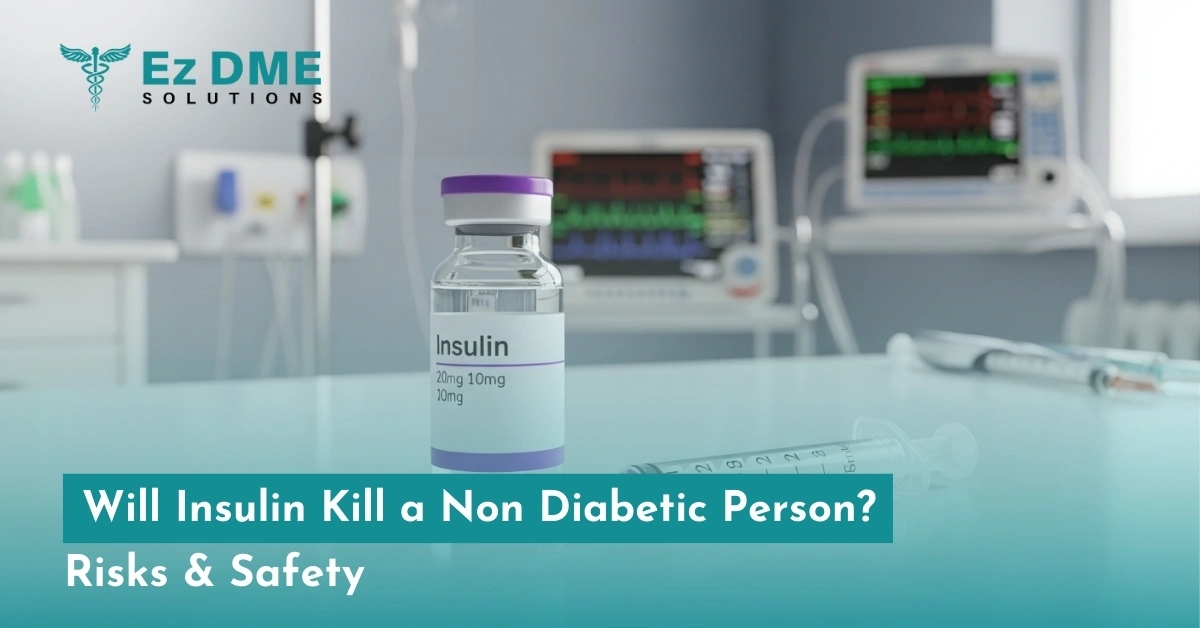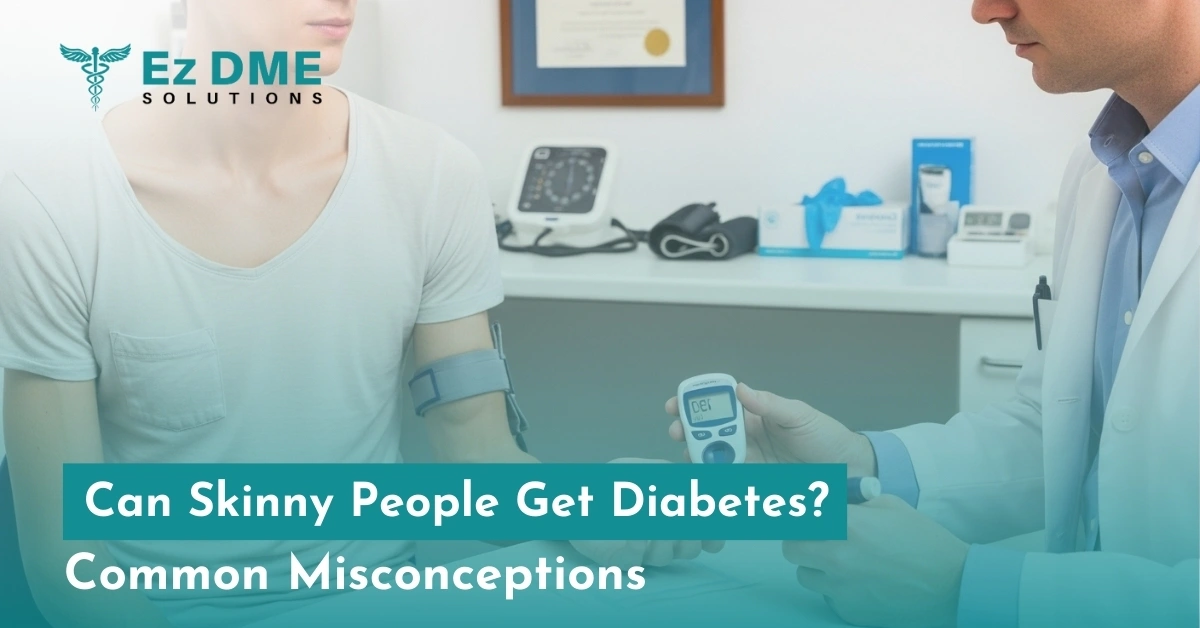No products in the cart.
Will Insulin Kill a Non Diabetic Person? Risks & Safety
Will insulin kill a non diabetic person? It’s a concern rooted in both curiosity and fear and for good reason. Though insulin is a crucial treatment for diabetics, it can be dangerous when taken in a wrong way. For example, the injection of insulin by a diabetic patient may result in severe and acute hypoglycemia. An abnormally low amount of glucose in bloodstream. If not treated quickly, the problem may cause convulsions, loss consciousness, or even death.
This article covers what using insulin results to, specifically regarding non-diabetics. It addresses myths, including over-simplifications around the potential dangers of taking too much insulin. It also emphasizes the critical warning signs to monitor as well as discuss essential measures to take in the event of an emergency.
What Happens if You Take Insulin Without Diabetes?
Insulin is essential for regulating the sugar levels in the blood. It aids cells in taking up glucose. In non-diabetic people who have normal pancreatic function and insulin secretion is managed the release of insulin is required to maintain the balance. However, if an exogenous dose of insulin is given to a non-diabetic person, it can disrupt this delicate balance.
The following occurs:
- There is rapid drop in glucose levels as cellular uptake of sugar as stimulated by insulin happens.
- Glucagon, epinephrine (adrenaline) and cortisol are some counter-regulatory hormones which try to reverse this drop.
- Failure of either these systems due to food being too low or excess dosing can lead to hypoglycemia.
- Shakiness with mild symptoms can worsen dramatically resulting into severe irreversible neurological damage
Can a Single Dose of Insulin Kill?
Understanding the Lethal Dose Myth
A single dose of insulin may not always be fatal, but under the wrong conditions (no food intake, sensitive metabolism, high dose), it can be. Factors that influence risk:
- Type of insulin: Rapid-acting insulin takes effect in 10–15 minutes; long-acting forms may affect blood sugar for up to 24 hours
- Physical status: A lean, fasted individual is more at risk
- Response time: Lack of immediate treatment increases mortality
Therapeutic vs Toxic Insulin Doses
| Insulin Type | Dose Range | Risk Level |
| Therapeutic (2–6 U) | For diabetic use | Safe under supervision |
| Moderate (10–20 U) | In fasted state | Can trigger hypoglycemia |
| High (>20 U) | Without food | Dangerous, potentially fatal |
Physiological Response in Non-Diabetics
In a healthy, well-balanced body, blood sugar levels are kept in check through a myriad of mechanisms:
- Glucagon triggers the release of glucose by the liver.
- Cortisol and Adrenaline aid in releasing stored energy.
- The kidneys and liver are responsible for regulating glucose levels.
The backup systems are effective in light situations However, when external insulin doses overflow into the body, these systems typically aren’t able to keep up. What did you get? Blood sugar levels that are dangerously low, also known as neuroglycopenia. This means that the brain is deprived of glucose.
How Much Insulin Is Dangerous?
| Insulin Dose | Expected Effect |
| Less than 3 units (fed state) | Drops in glucose levels that are mild can cause lightheadedness, hungry |
| 5–10 units (fasted) | Moderate hypoglycemia; sweating, dizziness, tremors |
| > 10 units | Risk of seizures, confusion or even a state of unconsciousness |
| ≫ 20 units | Life-threatening coma, or death if it is not treated immediately |
Monitoring glucose levels and the context (such as dietary intake or body weight) are crucial in assessing the risk.
Signs & Symptoms of Insulin Overdose
Early (Adrenergic) Symptoms
- Shakiness or trembling
- Sweating
- Irritability or nervousness
- Increased heart rate
- Sudden hunger
These are triggered by adrenaline as your body fights to raise glucose.
Severe (Neuroglycopenic) Symptoms
- Confusion or disorientation
- Slurred speech or blurred vision
- Drowsiness
- Seizures
- Loss of consciousness
If your blood sugar falls to below 54 mg/dL symptoms are more likely. Below 40 mg/dL, the brain is severely impaired, risking permanent damage.
Real-World Cases: Can Insulin Kill a Non-Diabetic?
Intentional Overdose
- Documented suicides by insulin injection exist.
- In healthcare, homicidal misuse of insulin has been used to covertly harm patients.
A forensic study showed that over 50% of fatal insulin overdoses were suicides, and nearly 40% were homicides, often involving non-diabetics.
Accidental Administration
- Children living in homes who are insulin users may have mistakenly self-injected.
- Medical errors in hospitals have caused non-diabetics to receive insulin by mistake.
These cases are a stark reminder that insulin is dangerous when misused, whether by accident or intent.
Bodybuilding and Non-Medical Insulin Use
Some in the fitness world use insulin without diabetes to try to improve muscle growth. This is highly dangerous and not supported by science.
- Taking insulin without carbs causes severe hypoglycemia after workouts.
- Multiple ER cases show users suffering seizures or coma.
- No clinical evidence shows that insulin has anabolic benefits in non-diabetics.
This is a case of serious risk with zero benefit.
Possible Long-Term Effects of Hypoglycemia:
If a person endures a severe hypoglycemic episode due to an insulin overdose, there can be enduring damage:
- Cognitive decline: Low glucose levels regularly restrain one’s memory and brain function.
- Electrolyte imbalance: Insulin impacts potassium and sodium which increases the arrhythmia risk for the heart.
- Heart attacks: Cardiac strain is markedly higher during these episodes.
- Mental health issues: Panic, trauma, and anxiety often accompany all of the aforementioned severe episodes.
Prevention is always safer than rescue.
Emergency Response & Treatment Protocol
First Aid at Home
- Check blood sugar with a glucometer.
- If BG is 54–70 mg/dL, give 15g of fast carbs (juice, candy, glucose tablets).
- If BG is < 54 mg/dL or symptoms are severe, give glucagon and call emergency services.
Hospital Treatment
- Administer IV dextrose (D50).
- Monitor cardiac function and electrolytes.
- Watch for delayed hypoglycemia from long-acting insulins.
Emergency Treatment Table
| Blood Glucose (mg/dL) | Action |
| 54–70 | Give 15g carbs; recheck in 15 minutes |
| < 54 | Inject glucagon and call emergency services |
| Unconscious | IV dextrose + continuous monitoring |
Why Insulin Doesn’t Kill Instantly
Insulin alone doesn’t usually cause instant death unless these are true:
- High dose taken
- Fasting or skipped meal
- No access to glucose or glucagon
- Delayed treatment
The body tries to recover with glucagon and liver glucose, but if overwhelmed, coma or death can result.
Preventing Accidental Insulin Overdose
Be sure to protect yourself and your family members by following these steps:
- Note all insulin with a clearly visible label particularly in shared households.
- Make sure to use safe storage for children (locked refrigerator compartments or boxes).
- Inform your family members or roommates on the dangers of using insulin.
- Look into Bluetooth CGMs and smart insulin pens in order to make sure that you don’t get dose errors.
- Keep insulin kits and snacks close by whenever insulin is required.
Take-Home Best Practices
- Never use insulin unless prescribed.
- Always monitor glucose, especially after insulin doses.
- In an emergency: Fast carbs → Glucagon → Hospital.
- Keep insulin secure and out of reach of children.
- Make sure everyone around you knows how to respond to low blood sugar.
Conclusion
Insulin is an important ingredient in the management of diabetes; however, it is also an extremely risky drug if it is taken care of properly. Incorrect use of insulin whether unintentionally or intentionally it can cause risks that could be serious, like hypoglycemia, seizures, and in extreme instances, death in people who are not diabetics.
By understanding how insulin works and spotting early warning signs, you can take action in time and avoid serious health problems.
Products like CGMs from EzDME, which come with auto-refill and insurance-covered delivery, make managing insulin much easier. Instead of dealing with last-minute emergencies, you can make insulin care a simple part of your daily life.
If diabetes runs in your family, it’s important to stay prepared, informed, and have the right tools. With the right knowledge and equipment, insulin can be the life-saving medicine it’s meant to be—without becoming a danger.
Frequently Asked Questions
Will insulin kill a non-diabetic person?
Yes, especially if taken in high doses without food or monitoring.
How much insulin can be fatal?
There isn't a specific dosage that is fatal however anything greater than 20 units for the body of a person who is fasting is extremely risky.
What happens if insulin given to someone who is not diabetic?
It is a cause of rapid hypoglycemia which could lead in coma, seizures or even death if not treated.
Does death from insulin pose really a danger?
Yes. Suicides, murders and accidental overdoses show that the risk is real.
What are the initial signs of an insulin overdose among non-diabetics?
The first sign is shaking sweating, shaking and a fast heartbeat. Nervousness and an abrupt hunger. The body's response to the decline in blood sugar levels.
What are the most severe signs of a high dose of insulin?
If not treated, symptoms can develop into blurred vision, confusion and seizures. They can also lead to unconsciousness, confusion or even death. They occur when glucose levels drop to levels that are below those of critical importance which means that the brain becomes depleted of energy.
Can a child die from accidental insulin injection?
Yes. Children are especially vulnerable due to their lower body mass. Even small doses can lead to dangerous hypoglycemia if not treated immediately.





Leave a Reply